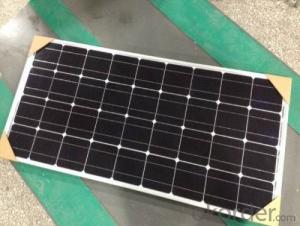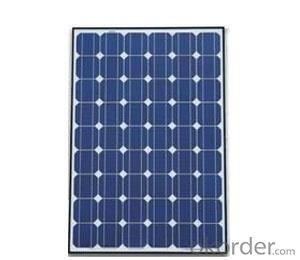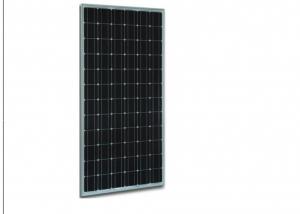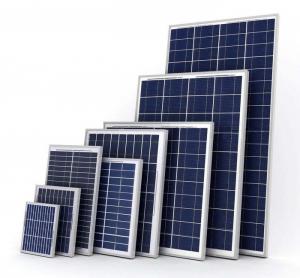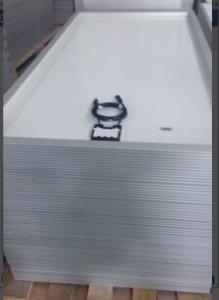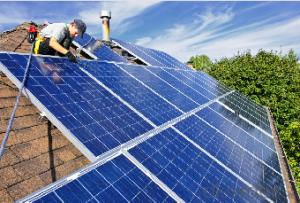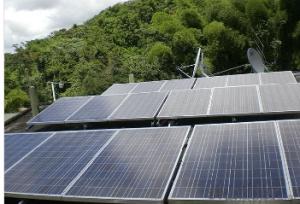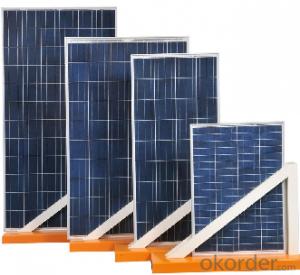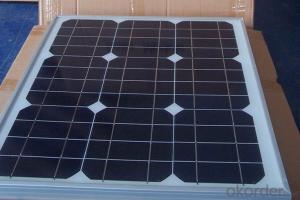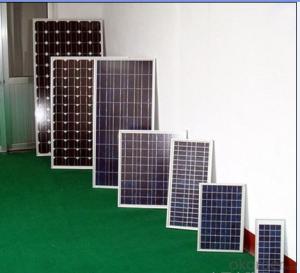Mse Solar Panels - Competitive Price Monocrystalline PV Solar Panel CNBM
- Loading Port:
- Qingdao
- Payment Terms:
- TT OR LC
- Min Order Qty:
- 10 set
- Supply Capability:
- 300000 set/month
OKorder Service Pledge
OKorder Financial Service
You Might Also Like
Monocrystalline PV Solar Panel
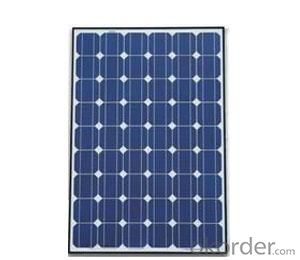
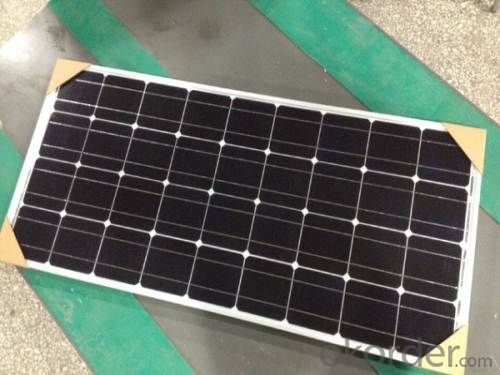
Quick Details
Place of Origin: | China (Mainland) | Brand Name: | CNBM | Model Number: | XRP-156M-250W |
Material: | Monocrystalline Silicon | Size: | 1620x992x40mm | Number of Cells: | 60 |
Max. Power: | 250w | Optimum Operating Voltage (Vmp): | 28.8V | Optimum Operating Current (Imp): | 8.68A |
Open Circuit Voltage (Voc): | 36V | Short Circuit Current (Isc): | 8.87A | Maximum Power at STC (Pmax): | 250W |
Operating Module Temperature: | -40 °C to +85 °C | Maximum System Voltage: | 1000 V DC (IEC) / 600V DC (UL) | Maximum Series Fuse Rating: | 15A |
Packaging & Delivery
Delivery Detail: | two weeks after order confirmation |
Features:
1) High Module conversion efficiency, through superior manufacturing technology
2) 0 to +5W positive tolerance for mainstream products
3) Certified to withstand high wind loads and snow loads
4) Anodized aluminum is for improving corrosion resistance
5) Anti-reflective, Highly transparent, low iron tempered glass
6) Excellent performance under low light environment
Benefit:
25-year performance warrant
10-year Product warranty
Electrical Characteristics:
Item No. | XRM-250W |
Optimum Operating Voltage (Vmp) | 28.8V |
Optimum Operating Current (Imp) | 8.68A |
Open Circuit Voltage (Voc) | 36V |
Short Circuit Current (Isc) | 8.87A |
Maximum Power at STC (Pmax) | 250W |
Cell Efficiency | 17.70% |
Operating Module Temperature | -40 °C to +85 °C |
Maximum System Voltage | 1000 V DC (IEC) / 600V DC (UL) |
Maximum Series Fuse Rating | 15A |
Power Tolerance | 0/+5 % |
STC: lrradiance 1000 W/m2, module temperature 25 °C, AM=1.5;
Best in Class AAA solar simulator (IEC 60904-9) used, power measurement uncertainty is within +/- 3%
Mechanical Characteristics:
No. of Cells | 60(6X10) |
Dimensions | 1640x992x40MM |
Weight | 20.0KGS |
Front | Glass 4.0 mm tempered glass |
Frame | Anodized aluminium alloy |
Temperature Characteristics:
Nominal Operating Cell Temperature (NOCT) | 45±2°C |
Temperature Coefficient of Pmax | -0.44 %/°C |
Temperature Coefficient of Voc | -0.33 %/°C |
Temperature Coefficient of Isc | 0.055 %/°C |
Refer to the Wmp range
Our factory can produce solar panel and solar module from 1.5W-290w (1.5w, 2.5w, 5w, 10w, 20w, 40w, 50w, 60w, 80w, 85w, 125w, 135w, 150w, 165w, 180w), according to customers requirement.
(A). Wmp range: 0.01W-6W, to be sealed with epoxy resin on PCB (printed circuit board), or to be sealed in plastic directly.
(B). Wmp range: 0.01W-15W, to be encapsulated with PET, on PCB (printed circuit board)
(C). Wmp range: 1W-60W, to be encapsulated with PET, on stainless steel, with holes for assembling purpose.
(D). Wmp range: 1W-290W, to be encapsulated with tempered glass, EVA, TPT, together with aluminium frame, junction box and (if necessary)diode and cable.
Refer to the material:
Monocrystalline solar cell or polycrystalline solar cell
Efficiency range 14%-17%, cell size 5/6.
- Q: in a solar panel, i know that the electrons are knocked loose and used as energy, what happens to the protons?
- silicon based photovoltaic cells used some boron as dopant. i dont understand if that helps supress proton pastime, the way they be conscious boron on supressing run away nuclear reaction.... im clueless as you
- Q: How do solar panels perform in extreme temperatures?
- Solar panels can still generate electricity in extreme temperatures, but their efficiency may be slightly affected. In high temperatures, solar panels may experience a decrease in their power output due to increased resistance in the electrical circuits. In extremely cold temperatures, solar panels may become less efficient temporarily, but they can still produce electricity as long as there is sunlight. Overall, while extreme temperatures can have a minor impact on solar panel performance, they are designed to withstand a wide range of weather conditions and continue to produce clean energy.
- Q: Solar panels are costly.Do you know any inexpensive way?So that i can make one of my own.
- Solar things are always costly... You can use concave mirrors and concentrate the heat and heat what and then steam ll be formed and then steam directed to turbines, there you go generating electricity with out solar panels...
- Q: Can solar panels be damaged by birds or other animals?
- Yes, solar panels can be damaged by birds or other animals. Birds may create nests under solar panels, which can cause damage to the wiring or block sunlight. Additionally, animals like squirrels or rodents can chew on the wires, potentially causing electrical issues. It is recommended to take preventive measures, such as installing barriers, to protect solar panels from such damage.
- Q: Can solar panels be used in areas with high levels of pollution from industrial activities?
- Yes, solar panels can be used in areas with high levels of pollution from industrial activities. While pollution may have some impact on the efficiency and performance of solar panels, they can still generate electricity even in polluted areas. It's important to regularly clean the panels to maintain their optimal efficiency and ensure maximum energy production. Additionally, investing in advanced technologies and air pollution control measures can help mitigate the effects of pollution and improve the overall effectiveness of solar panels in such areas.
- Q: How do solar panels impact the electricity bill?
- Solar panels can significantly reduce or even eliminate electricity bills by generating clean and renewable energy from the sun. By harnessing solar power, homeowners can offset their electricity usage with the electricity produced by the panels, resulting in lower overall energy costs.
- Q: Can solar panels be installed on shopping malls or retail centers?
- Yes, solar panels can be installed on shopping malls or retail centers. In fact, many commercial buildings are increasingly adopting solar energy systems to reduce their carbon footprint and save on electricity costs. Installing solar panels on shopping malls or retail centers can provide a sustainable and renewable energy source, contributing to their overall green initiatives.
- Q: I am going to be building green in the next couple of years and i need an idea of how many solar panels i need in addition to a wind turbine to sufficiently handle a workshop, house, green house, etc. and what the approximate cost will be.
- With out the kW information of the need for your workshop no one can really tell you what you need for power supply. I would recommend you orientate your building or shop to maximize the passive solar potential. this will drastically eliminate your excessive need for heating and cooling. Which in turn will maximize your solar energy from the panels. Also depending upon what state you live in do some further research into any programs or grants offered by the power companies or state incentives. Regarding hydrogen...for get about it.
- Q: I am intrested in buying solar panels to save a buck and even maek some money off of it but I was wondering what kind? How Much? How Many? Are they easy to install? Whats the best brand? I want alot of information on this if anyone can give me some help on it in a user friendly way it would be appreciated!
- You will not recoup your cost in utilities savings. you will get it back in state and federal tax credits and accelerated depreciation on the system. You also have to be aware that a KV system for example is different in different climates. I just priced a system that is in Malibu,CA and it is very efficient due to sun exposure. the same system in Idaho will not create the same amount of power output. Therefore will not save the same amount on utilities. I have included a plug and play system that just came on the market. But there are other systems available.
- Q: Can solar panels be used to power a hospital?
- Yes, solar panels can be used to power a hospital. Solar panels generate electricity by converting sunlight into energy, which can be used to power various electrical systems in a hospital, such as lighting, medical equipment, and heating/cooling systems. Solar power can provide a reliable and sustainable source of energy for hospitals, reducing their dependence on traditional energy sources and helping to lower operational costs.
Send your message to us
Mse Solar Panels - Competitive Price Monocrystalline PV Solar Panel CNBM
- Loading Port:
- Qingdao
- Payment Terms:
- TT OR LC
- Min Order Qty:
- 10 set
- Supply Capability:
- 300000 set/month
OKorder Service Pledge
OKorder Financial Service
Similar products
Hot products
Hot Searches
Related keywords
